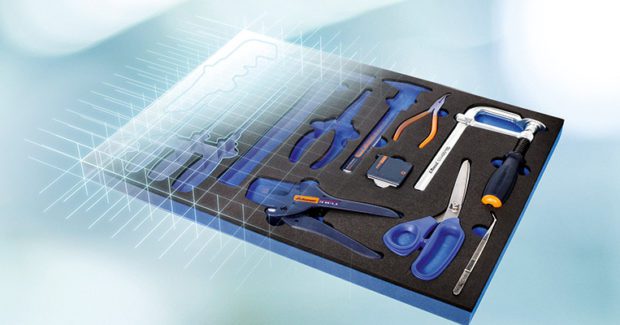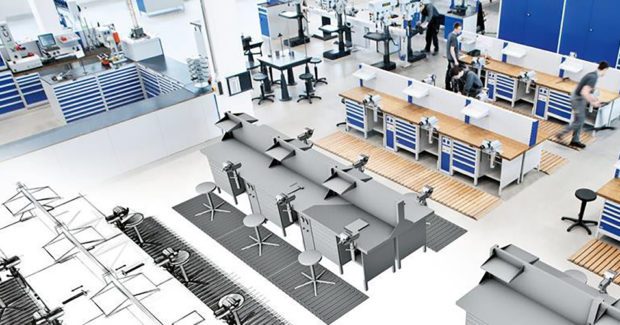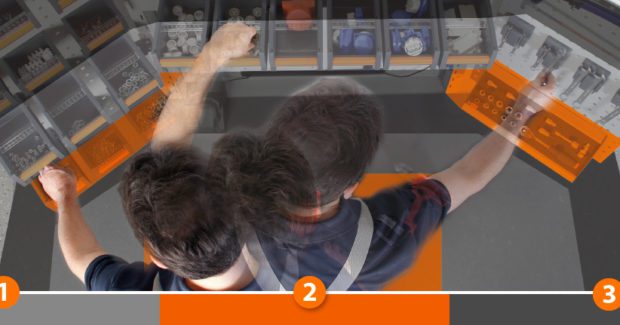Applying Principles of Order to Workplace Design
5S design of an industrial work environment by Hoffmann Group can guarantee plant aesthetics and operational functionality even when future changes are made, so that employees still feel good in their workspace and remain productive.
Posted: July 14, 2018
Introducing a well-thought out order system improves efficiency and ensures that employees can also orientate themselves quickly and always have the necessary tools quickly at hand. The Japanese 5S design of the industrial workplace is a well-tried and proven concept. Because every person is different, 5S includes factors such as the lighting mix, arm length, body height and size of the employees, who should also be able to understand their work environment at a glance and quickly find their way around. 5S is accomplished using the five principles of order: selection, arrangement, cleanliness, standardization and self-discipline.
RELIEVE STRAIN ON THE BODY
A basic requirement for being able to concentrate on work without getting tired is a well-illuminated workplace with an optimized mix of lighting, which influences the biorhythm. A balanced mix of direct and indirect light, as well as workplace lighting and daylight is perfect. For sufficient light, the ratio of translucent areas (windows, doors and skylights etc.) should be at least 1:10 to the room surface area. For work which involves especially high visual requirements, then a ratio of 1:5 is needed. Individually adjustable workplace lights should be used for concrete visual tasks, where the immediate workplace surroundings are well illuminated and avoids creating shadows.
So that the eyes don’t have to keep re-focusing and to keep the employee from having to bend down too much, tools and other things should be placed in the corresponding fields of vision according to their importance, and it should also be possible to adjust the space of reach. Using 5S, the storage place for a tool depends on its frequency of use. Having to bend over frequently is bad for the back and having to constantly re-focus the eyes puts excessive strain on them. Tools are positioned according to importance within the employee´s field of sight, using swiveling perforated side walls to adjust the workplace to an arm’s length. This means that grip holders, tools and visual information are always the same distance away from the employee.
For example, uncluttered storage is offered by perforated panels that can be customized using Garant Easyfix hooks and holders. E-shaped foam inserts with gaps in the shape of tools are used to give a quick visual overview in tool drawers to determine whether any tools are missing.
Because lots of tasks are performed standing up, some sort of alleviation should be provided. For employees who must spend more than two minutes standing up in the same position, seating or standing aids can provide help by absorbing up to 60 percent of the body weight. Anti-tiredness mats placed in front of the workplace can provide additional relief for the joints and help improve the circulation in the legs. Lots of tiny movements in the legs are necessary to keep their balance on the mats. Also, open anti-tiredness mats collect dirt particles and decrease the possibility of slipping. Another advantage of anti-tiredness mats is that they absorb the noise and keep noise emissions down. They also keep the employee shielded from the cold from the ground and reduce the stress caused by noise.
ADJUST THE WORKING HEIGHT
To prevent back problems, damage to posture, or alleviate tension in the neck and shoulders, it’s important to be able to adjust the height of the workbench or workstation. Decisive for the right working height, along with the employee’s body size and height, is also the task that must be completed, as well as the dimensions of the piece being worked on. The ideal working height is generally “below the heart” height: depending on whether the work is being carried out standing up or sitting down, but between 27.6 in and 59 in is recommended. Tasks that require a lot of power need a working height 5.9 in to 15.75 in below the elbow. For very precise mechanical tasks, it’s 3.9 in to 7.9 in above the elbow.
Modern workbenches and workstations are available with a manually or electrically height-adjustable work surface. If employees work on different-sized components at their workplace, then it’s enough if they can adjust the height of the work surface. In a multi-shift environment, completely height-adjustable workstations are recommended so that each employee can adjust the workstation exactly to their height. Modern electrically-adjustable workbenches and workstations have a memory function for quick and easy set up.
SIMPLIFY MOBILITY
Because some employees must be mobile on the company premises, there are also workbenches available with a drive unit so that vices, tools and other heavy objects are always positioned where they are needed to eliminate carrying heavy things. This relieves the strain on the back. For employees who need a solid and stable workbench but don’t change their location very often, electronically height-adjustable workbenches are available with mobile power supply, wheels and electronically retractable and extendable feet. After the feet have been extended, the workbench can simply be moved to another place along with the powerful battery that supplies power for electrical tools.
For employees who must move considerable distances during their shift, a movable workbench with electric drive is available that can move up to 2.5 mph forwards and backwards. This means the entire workstation area can be moved around without any real effort, even over greater distances.
ERGONOMIC PPE AND TOOLS PREFERRED
The choice of personal protective equipment (PPE) has a great influence on the well-being, safety and productivity of the employees: Safety shoes with a suitable damping system don’t only offer the necessary protection, but also help to prevent back pain. Breathable, highly-flexible gloves for assembly work offer protection and grip, and the necessary fine feeling from the hands. Work clothing needs to be flexible, offer high flexibility of movement and be well-designed.
Tools should not only be designed from an aesthetic perspective, but also from an ergonomic point of view. For example, screwdrivers with rounded handles can transfer power more efficiently. Tools with Santoprene grips lie better in the hands and prevent premature fatigue. Good grip is especially important for wet or oily hands. Special attention should also be paid to hand-held and hand-guided electric tools as they often transmit vibrations to the hand-arm system and could cause circulation problems for the fingers and hands. Low vibration tools and technical aids for vibration reduction provide relief.
Hoffmann Group USA, 202 North Seven Oaks Drive, Knoxville, TN 37922, 844-448-7725, Fax: 877-550-7778, sales.usa@hoffmann-group.com, www.hoffmann-group.com.






